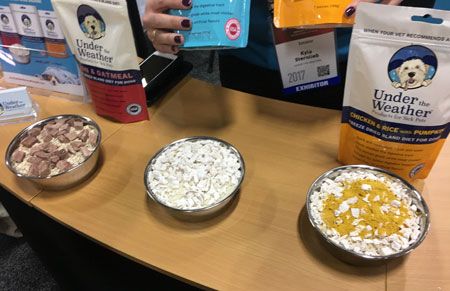From WVC 2017: Take a gamble on new veterinary products
We went to Vegas and all we got was this amazeballs roundup of whats new and coming to a show floor near you.

Shutterstock.com
What happens in Vegas doesn't always stay in Vegas. In fact, we're spilling the beans here to help you make some safe bets on purchases for your veterinary practice with this quick product guide.
Cancer cells can't take the heat
Could 40 C (104 F) be key to curing cancer? Hyperthermia is a cancer treatment modality that has taken off in human medicine and is now coming to the veterinary market via Midmark's deep tissue heating system Thermofield. This microwave technology in the form of a heating pad is designed to be used in conjunction with chemotherapy and radiation therapy for superficial tumors within 4 cm of the skin's surface, enhancing their effects on those malicious malignant tumor cells.
How can heat application aid in cancer treatment? Midmark says this adjunctive form of cancer therapy:
• Triggers the release of cancer-fighting immune system components
• Helps the immune system recognize cancer cells by expressing heat shock proteins
• Increases blood flow in the target area to deliver more chemotherapeutic drug to the tumor
• Increases the cytotoxicity of chemotherapy
• Makes cancer cells more sensitive to radiation
• At higher temperatures, damages tumor vasculature and kills cancer cells
• Inhibits a cancer cell's ability to repair its DNA
• Mitigates pain
The heated pad will quickly bring the targeted area to 40 C and stays on the patient for 45 minutes. It's best to keep the patient sedated so that the pad remains in the exact spot you're targeting. Worried about burning the skin? The applicator is designed to emit a time-variable electromagnetic field that projects into the tissue, sparing the skin.

Not lame at all
Take a stance on the way pets stand with the Stance Analyzer from Companion Animal Health (formerly Companion Therapy Laser-they're branching out, you see). Whether you're using the product to evaluate lameness or measuring the improvements you see during rehabilitation, this analyzer offers objective measurements to see how patients are shifting their weight to determine which limbs are affected. So the next time Mrs. Doubt says, “Are you sure that underwater treadmill is helping Baxter?” you can put Baxter on the Stance Analyzer mat and let the data speak for you (it only uses nice language, we promise). Check it out here.
Strengthen your core
Buy a new piece of equipment for your veterinary practice and you risk turning it into a fancy coat rack if you don't train on it, charge for it and market it to clients. In further news from Companion, the company is offering a paid service called Companion Core that provides one-on-one consulting, an iPad educational app, exclusive webinars for team member training, and client-facing marketing materials to get that new piece of equipment used, charged for and paid off.
"This is for the veterinarian who wants to do laser therapy, but doesn't have the time to train staff," says Companion's Carl Bennett. "It takes away the fear the doctor has that they got the training but don't know where to take it."
Add the service when you make an equipment purchase to help ensure you'll put that new machine to use in your hospital. DYK? Bennett tells us all the cool kids in human medicine call laser therapy "photobiomodulation."

Just say no (to the cone)
Say goodbye to the cone of shame and hello to this frankly adorable onesie for pooches, kitties and bunnies. Medical Pet Shirts are cotton/Lycra garments billed as full-body bandages to help protect wounds and dressings. The doggie versions come in several sizes and offer easy-to-undo snaps for strategic potty breaks. (The cat and rabbit versions don't cover the tush for obvious reasons … unless your clients routinely walk these pets for potty breaks instead of using a litter pan.) Want to see all sizes and options? Visit medicalpetshirts.com. (If you're a cat lady, it's worth noting they have a new limited edition leopard-print version for cats only.)
Scratch payment plans off your list
Caleb Morse describes his journey into the veterinary world with a simple story: He and his wife found a cat in a dumpster, and a few short months later they were ponying up $4,000 and later $10,000 for expensive visits to the emergency room. Now he and partner John Keatley are rolling out Scratch to veterinary practices to help pet owners pay for unexpected bills. Here are the basics:
• Pet owners apply on their smartphones with any participating veterinarian-no credit check "ding" on the pet owner's record (and the process takes less than two minutes).
• Scratch offers pet owners up to $10,000 to finance over one year or pay interest-free within 30 days. There is no prepayment penalty. Morse says Scratch pays the practice the next business day.
• Once a pet owner signs off and is approved (no credit check necessary), emails go out to the pet owner and the veterinarian, who can use an email link to bill Scratch directly. Veterinarians pay a base 5 percent per invoice, no matter the Scratch financing option.
Compare these basic financing features to other alternatives for your clients, including CareCredit and Veterinary Payment Plans, for a menu of ways to help pet owners pay.
Stop the jaws of death
CVC educator Dr. Dave Nicol recently dropped knowledge about his love for veterinary dental radiography (you need it!) and the reasons he chose computed radiography over digital-for one, it costs less to replace the cassettes if a dog bites down under anesthesia.
Well, we just saw the new product Midmark wants to sell Nicol (and maybe you): the VetPro OptiMax Digital Sensor System. The system's veterinary-specific DR sensor is built with more protective layers and a "flying buttress" on the back that protects it from unfortunate feline and canine jaw clamp-downs. The cost difference between the new OptiMax sensor and the former model is just about the cost of the protection plan you'd use if the old sensor got crunched.

Don't cry for me, Lhasa apso
Those tear stains are often simply a cosmetic problem, but if you're growing tired of the constant complaints about Alfie's unsightly undereyes, you can skip the powder solution and recommend a once-a-day soft, chewy, real beef treat. OcuBright, available exclusively through veterinarians, can zoom you past this tricky conversation so you can scoot on to other important medical topics, like Alfie's sebaceous adenitis or the dental cleaning he definitely needs.
Technicians can take TOBI's advice
One of the coolest things about the new therapy laser from Sound, the DoctorVET Small Animal Laser, is how you get the instructions. They're not in a manual or a PDF but pop up during use for the particular species and type of condition you're treating on a tablet-like display.
The mascot is a bow-tied puppy named TOBI (Treatments with Onboard Instructions). He doesn't show up on-screen, unfortunately, but his advice about where and how to focus the laser for a particular treatment does.
"As a society we think we should be able to turn something on and use it immediately," says Sound's Steve Nielsen. He hopes TOBI will make laser therapy training easier for both veteran and newbie technicians alike.
Nielsen also estimates that DoctorVET is a few thousand dollars less than comparable models. Go check prices with major competitors like Companion and K-Laser and compare their user-friendly displays.
Has this ever happened to you? You're busting out the ultrasound at the veterinary practice and you're not totally sure the veterinarian or the technician has the wand in just the right spot. Sound feels your pain. So its new briefcase-sized Logiq V2 Vet, using GE technology from the human healthcare side, offers a bit more help in the moment. During procedures, the Scan Coach shows reference images while you are live scanning: an on-screen photo example of what the wand looks like on the patient as well as an image of the anatomy of the location. The company only had demo images to show during WVC, but it plans to release protocols soon for FAST (focused assessment with sonography in trauma) and Big 5.

To dinnertime and beyond!
It's kind of like astronaut food for pets-only most pets probably aren't planning a trip to space anytime soon and never took a class in science or engineering. But if your patients are feeling under the weather, you might recommend, well, Under the Weather. It's a freeze-dried bland diet for those times when you'd normally say, “Just feed him chicken and rice for the next day or so.”
The “pet parent” (this phrase is increasingly common in industry, we're finding) simply adds water-it's as simple as preparing a package of ramen. The diet is made from human-grade meats; it's gluten-free, with no artificial flavors dyes or chemicals; and it comes in three flavors: chicken and rice, bison and oatmeal, and chicken and rice with pumpkin. Packages range from 6 to 7 oz, and the suggested retail is $11.99.
Don't brush this off
A human orthodontist, Salvatore DeRicco, is visiting veterinary conferences this year to talk up his Gumliner II and Lil Gumliner II, which he says are improvements on the human-toothbrush-turned-pet-toothbrush products on the market. His models sport a thinner line of bristles to focus on the gum line without punishing the gums, especially when brushing those tiny feline teeth. Both the cat and dog versions feature a flexible curve and tiltable brush to reach those hard-to-get maxillary molars. Learn more at pettoothbrushes.com. (And, yes, you can get your practice name imprinted on the product.)
The “C” word
DYK? Blue Buffalo wants to help pet owners be a little less afraid of the "C" word this May. The pet food company will share marketing materials in the nation's Petco stores educating your clients about early signs of cancer in pets. Stay tuned for an update soon!